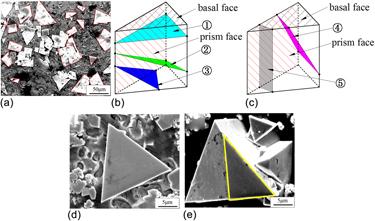Article contents
Phase constituents and growth mechanism of laser in situ synthesized WC reinforced composite coating with W–C–Ni system
Published online by Cambridge University Press: 12 December 2016
Abstract

The in situ synthesis of nickel-based composite coating reinforced with WC particle on mild steel has been investigated. Results show a planar crystal at the interface and some relatively coarse columnar dendrites on the side of the coating near the substrate. The synthesized WC particles homogenously distribute in the coating without cracks and pores. The maximum size, mean size, and volume fraction of the WC particle is 270 µm, 35 µm, and 71%, respectively. The microhardness value of the prepared coating can be up to a maximum of 755 HV2. The synthesized WC particles generally show a unique triangular prism shape, whose evolution rule and growth mechanism are investigated by Bravais–Friedel–Donnay–Harker theory. It is deduced that crystal structure and interface energy play important role in determining the shape of WC, which evolves from sphere to hexagonal prism and finally to triangular prism.
- Type
- Articles
- Information
- Copyright
- Copyright © Materials Research Society 2016
Footnotes
References
REFERENCES
- 10
- Cited by





